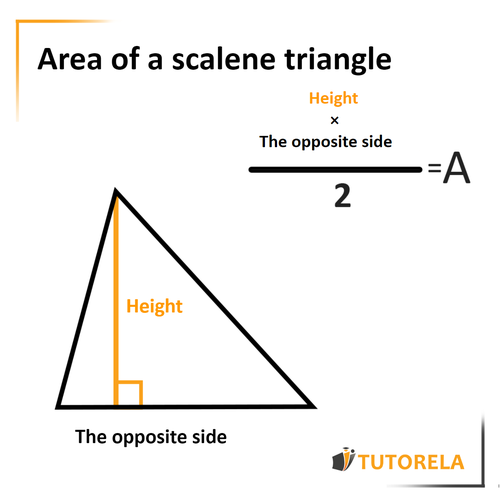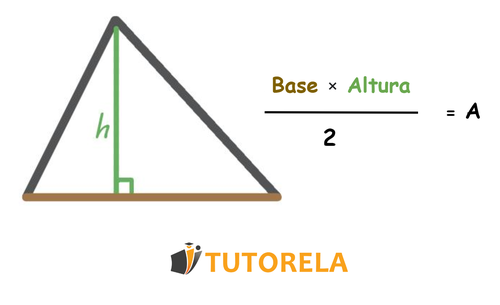Formula to calculate the area of a scalene triangle:

Formula to calculate the area of a scalene triangle:

Calculate the area of the following triangle:
Calculate the area of the following triangle:
Calculate the area of the right triangle below:
Calculate the area of the triangle ABC using the data in the figure.
Calculate the area of the triangle below, if possible.
Calculate the area of the following triangle:
The formula for calculating the area of a triangle is:
(the side * the height from the side down to the base) /2
That is:
We insert the existing data as shown below:
10
Calculate the area of the following triangle:
The formula for the area of a triangle is
Let's insert the available data into the formula:
(7*6)/2 =
42/2 =
21
21
Calculate the area of the right triangle below:
Due to the fact that AB is perpendicular to BC and forms a 90-degree angle,
it can be argued that AB is the height of the triangle.
Hence we can calculate the area as follows:
24 cm²
Calculate the area of the triangle ABC using the data in the figure.
First, let's remember the formula for the area of a triangle:
(the side * the height that descends to the side) /2
In the question, we have three pieces of data, but one of them is redundant!
We only have one height, the line that forms a 90-degree angle - AD,
The side to which the height descends is CB,
Therefore, we can use them in our calculation:
36 cm²
Calculate the area of the triangle below, if possible.
The formula to calculate the area of a triangle is:
(side * height corresponding to the side) / 2
Note that in the triangle provided to us, we have the length of the side but not the height.
That is, we do not have enough data to perform the calculation.
Cannot be calculated
The triangle ABC is given below.
AC = 10 cm
AD = 3 cm
BC = 11.6 cm
What is the area of the triangle?
What is the area of the given triangle?
What is the area of the triangle in the drawing?
Calculate X using the data in the figure below.
PRS is a triangle.
The length of side SR is 4 cm.
The area of triangle PSR is 30 cm².
Calculate the height PQ.
The triangle ABC is given below.
AC = 10 cm
AD = 3 cm
BC = 11.6 cm
What is the area of the triangle?
The triangle we are looking at is the large triangle - ABC
The triangle is formed by three sides AB, BC, and CA.
Now let's remember what we need for the calculation of a triangular area:
(side x the height that descends from the side)/2
Therefore, the first thing we must find is a suitable height and side.
We are given the side AC, but there is no descending height, so it is not useful to us.
The side AB is not given,
And so we are left with the side BC, which is given.
From the side BC descends the height AD (the two form a 90-degree angle).
It can be argued that BC is also a height, but if we delve deeper it seems that CD can be a height in the triangle ADC,
and BD is a height in the triangle ADB (both are the sides of a right triangle, therefore they are the height and the side).
As we do not know if the triangle is isosceles or not, it is also not possible to know if CD=DB, or what their ratio is, and this theory fails.
Let's remember again the formula for triangular area and replace the data we have in the formula:
(side* the height that descends from the side)/2
Now we replace the existing data in this formula:
17.4
What is the area of the given triangle?
This question is a bit confusing. We need start by identifying which parts of the data are relevant to us.
Remember the formula for the area of a triangle:
 The height is a straight line that comes out of an angle and forms a right angle with the opposite side.
The height is a straight line that comes out of an angle and forms a right angle with the opposite side.
In the drawing we have a height of 6.
It goes down to the opposite side whose length is 5.
And therefore, these are the data points that we will use.
We replace in the formula:
15
What is the area of the triangle in the drawing?
First, we will identify the data points we need to be able to find the area of the triangle.
the formula for the area of the triangle: height*opposite side / 2
Since it is a right triangle, we know that the straight sides are actually also the heights between each other, that is, the side that measures 5 and the side that measures 7.
We multiply the legs and divide by 2
17.5
Calculate X using the data in the figure below.
The formula to calculate the area of a triangle is:
(side * height descending from the side) /2
We place the data we have into the formula to find X:
Multiply by 2 to get rid of the fraction:
Divide both sections by 5:
8
PRS is a triangle.
The length of side SR is 4 cm.
The area of triangle PSR is 30 cm².
Calculate the height PQ.
We use the formula to calculate the area of the triangle.
Pay attention: in an obtuse triangle, the height is located outside of the triangle!
Double the equation by a common denominator:
Divide the equation by the coefficient of .
/
15 cm
The area of triangle ABC is 20 cm².
Its height (AD) is 8.
Calculate the length of the side BC.
Which of the following triangles have the same areas?
Below is the right triangle ABD, which has a perimeter of 36 cm.
AB = 15
AC = 13
DC = 5
CB = 4
Work out the area of the triangle.
Calculate the area of the
triangle ABC given that its
perimeter equals 26.
The triangle ABC has a perimeter measuring 42 cm.
AD = 12
AC = 15
AB = 13
Calculate the area of the triangle.
The area of triangle ABC is 20 cm².
Its height (AD) is 8.
Calculate the length of the side BC.
We can insert the given data into the formula in order to calculate the area of the triangle:
Cross multiplication:
Divide both sides by 8:
5 cm
Which of the following triangles have the same areas?
We calculate the area of triangle ABC:
We calculate the area of triangle EFG:
We calculate the area of triangle JIK:
Therefore, the triangles that have the same areas are ABC and EFG.
EFG and ABC
Below is the right triangle ABD, which has a perimeter of 36 cm.
AB = 15
AC = 13
DC = 5
CB = 4
Work out the area of the triangle.
According to the data:
Now that we are given the perimeter of triangle ABD we can find the missing side AD:
Thus we can calculate the area of triangle ABD:
54 cm²
Calculate the area of the
triangle ABC given that its
perimeter equals 26.
Remember that the perimeter of a triangle is equal to the sum of all of the sides together,
We begin by finding side BC:
We then move the 16 to the left section and keep the corresponding sign:
We use the formula to calculate the area of a triangle:
(the side * the height) /2
That is:
Lastly we insert the existing data:
30
The triangle ABC has a perimeter measuring 42 cm.
AD = 12
AC = 15
AB = 13
Calculate the area of the triangle.
Given that the perimeter of triangle ABC is 42.
We will use this data to find side CB:
Now we can calculate the area of triangle ABC:
84 cm²